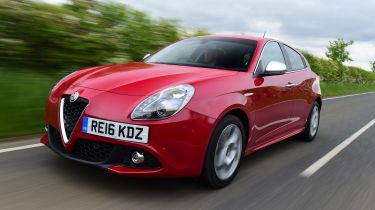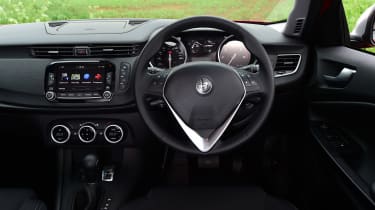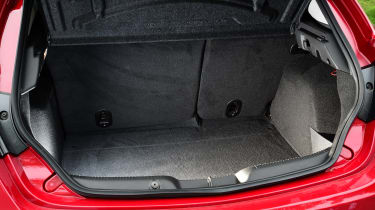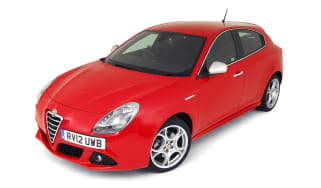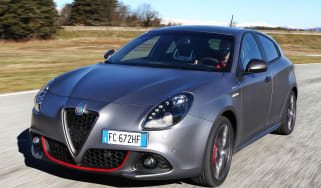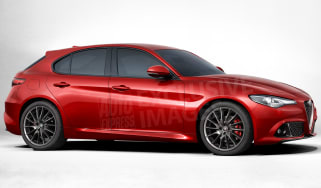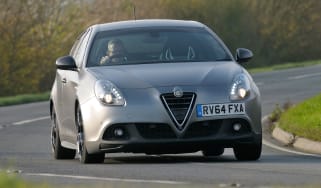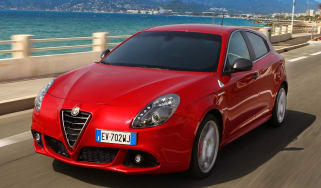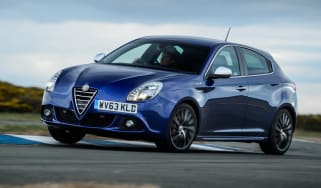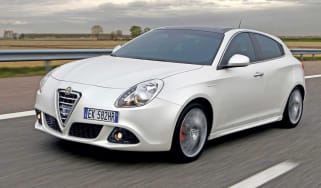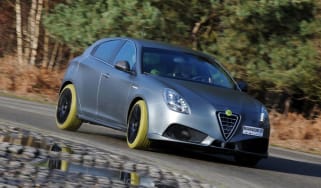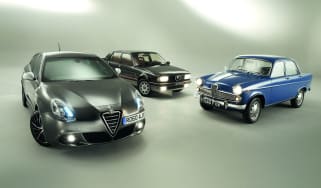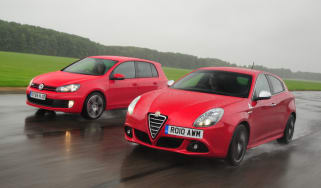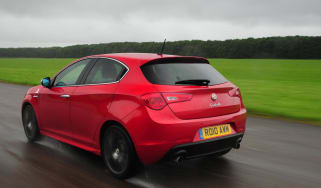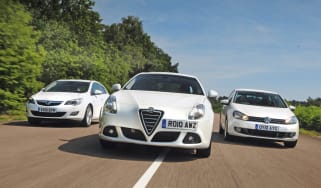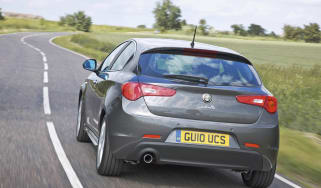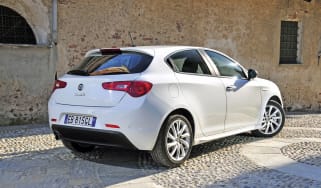Alfa Romeo Giulietta (2010-2020) review
The Alfa Romeo Giulietta is one of the prettiest hatchbacks around. It’s fun to drive too but quality and practicality issues let it down

On its looks alone the Alfa Romeo Giulietta appears unbeatable, but you don’t need to scratch far beneath that stylish surface to uncover some serious compromises.
Those pretty lines and an energetic driving experience backed up particularly well by the turbo petrol engines count in the Giulietta’s favour. It’s hindered, however, by occasionally average ride quality and – more crucially for a car with such obvious sporting intentions - poorly judged drive mode settings for the D.N.A system that fail to satisfy the enthusiastic driver.
The overall picture for the Giulietta isn’t helped by a cramped interior with poor quality plastics in places and an awkward driving position. The reflections of owners we’ve surveyed over reliability and build quality don’t inspire much confidence – although residual values are holding up well.
The Alfa Romeo Giulietta has been for sale at Alfa dealers for nearly 10 years now. It has gone through a number of configurations in that time, and if you're a compact hatchback buyer who wants some sport to go with your practical family car, it could be for you.
However, as it's been on sale for so long, it's not a cutting-edge machine - it wasn't really a class leader when it was brand-new, either. It's a car that has relied on its looks to paper over the shortcomings it has in other areas, and really you'd need to be a diehard Alfa fan to consider one over a number of rivals that outclass it in nearly every area.
Used - available now

2022 BMW
3 Series
27,305 milesAutomaticPetrol2.0L
Cash £22,300
2020 BMW
3 Series
61,740 milesAutomaticDiesel2.0L
Cash £19,300
2025 Kia
Niro EV
28,985 milesAutomaticElectric
Cash £19,900
2020 Ford
Focus
69,320 milesManualDiesel1.5L
Cash £9,400Many rivals have gone through wholesale generation changes during the Giulietta's time on sale. The Ford Focus is on to the Mk4 version, the Vauxhall Astra the Mk7, and the car that's closest to the Alfa's philosophy, the SEAT Leon, is also newer, but that's considered an older car in the class these days, having been launched in 2012. Another compact hatchback with a bit of a sporty edge is the Mazda 3, but while the Mk2 Mazda 3 launched in the same year as the Giulietta (2010), the Mazda is now on to its Mk4 variant.
Back to the Giulietta, the line-up in 2019 comprises standard, Sport and Super trims, while the Veloce hot hatchback (formerly Cloverleaf) was offered up until 2018. That car came with a 1.75-litre turbo four-cylinder engine with a healthy 237bhp, although it never really had the handling to compete with cutting edge hot hatchback rivals.
The range now uses either a 1.4 TB 120hp petrol or a 1.6 JTDM-2 120hp diesel. These both come with 118bhp, while the Giulietta has a conventional front-engine, front-wheel-drive layout. Both engines come with a 6-speed manual gearbox as standard, while the diesel can be had with a 6-speed TCT auto, but only in Super trim. The standard car only comes with the 1.4 petrol engine.
Whichever engine you choose, they're not as efficient as newer units found in rivals, although the petrol motor has a sporty character that's fitting for the Giulietta. All cars feature Alfa's DNA switch, which adjusts the car's performance, ranging from sporty to efficient driving depending on which option you choose, although all three settings demand compromises of one sort or another.
Inside, the Alfa looks smart, but it's not the most spacious compact hatchback. There's just one body style, a five-door hatchback, leaving you little choice if you want more practicality or an even sportier looking model with an Alfa badge.
Engines, performance and drive
The Alfa Romeo Giulietta has a blend of comfort and performance that's genuinely effective, and it's at home on the motorway, uneven city streets and winding country roads. Noise is well controlled in the cabin and the car corners like a hot hatch, resisting body roll well.
The Giulietta gets what Alfa calls its DNA switch. This alters the throttle response and steering weight between three driving modes: Dynamic, Natural and All-weather. Unfortunately, it feels like a gimmick and fails to provide a satisfying compromise between aggression and comfort, with too much weight in Dynamic mode and slack throttle response in the Natural and All-weather settings.
The suspension on the Alfa Romeo Giulietta isn’t supple enough to soak up many of the worst bumps on UK roads, and together with questionable cabin ergonomics it means the Giulietta isn’t the most comfortable car to live with.
Engines
Twin-clutch (TCT) models get the option of paddle shifters mounted behind the steering wheel for manual gear changes if you want a sportier drive. While this was available on older 168bhp petrol and 173bhp diesel engines, the 118bhp diesel is the only one offered with an auto now. It’s a decent gearbox, shifting smoothly when cruising and quick to drop a few ratios if prompted to do so by the paddles but it’s up against some stiff competition from other twin-clutch autos on the market.
If you want a relatively quick diesel Giulietta, then your only choice is to search the used market for the 173bhp diesel. With lots of low-down torque on offer, it manages 0-62mph in 7.8 seconds. The more popular 1.6-litre 118bhp unit takes 10.2s to do the sprint or 10s if you stick with the manual gearbox. Either way it feels reasonably lively without making much noise.
As for the petrol line-up, the 1.4 litre turbocharged petrol works better in Alfa’s smaller MiTo as it can struggle with the comparative bulk of the Giulietta. It remains a charismatic unit though, and it's keen to rev.
For fans of the hot hatch there is the Veloce, with the same engine found in the 4C sports car. Producing 237bhp, it has a Golf GTI-bothering top speed of 149mph.
This makes it one of the fruitiest-sounding hot hatchbacks around, but it's far from the most entertaining to drive. The dual-clutch gearbox isn't quite as snappy when driving quickly as those in the Veloce's main rivals, nor is it as smooth to shift when pootling through town.
MPG, CO2 and Running Costs
The Giulietta's engine range has been slimmed down over the years, and only the later 118bhp 1.4 TB petrol and 1.6 JTDM diesel have been tested under the latest WLTP test procedure. The 1.6-litre diesel returns up to 49.6mpg on this test, and that's the same figure for the TCT auto model. In comparison, the older NEDC test saw the 1.6 JTDM return 74.3mpg on the combined test cycle. That doesn't mean the newer diesel is less efficient, it's just that the different test returns a result that you're more likely to achieve in everyday driving.
Emissions for the 1.6 JTDM have changed from 99g/km for older cars (so there's free road tax for cars registered before April 2017), to 123g/km today. The TCT box raises this figure slightly to 125g/km.
Our pick of the older engines that used to be available with the Giulietta is the larger 2.0-litre turbodiesel. This 148bhp engine hasn't been tested under WLTP regs, but its older NEDC figures of 110g/km of CO2 and 67.3mpg are only marginally worse than the 1.6 JTDM. Both turbocharged diesels are fitted with fuel-saving stop-start technology as standard.
The 1.4-litre petrol engine in its lowest powered 118bhp form returns up to 36.2mpg on the WLTP test (45.6mpg combined on NEDC) and emits 164g/km of CO2 (up from 144g/km). Again, the older petrol engines haven't been WLTP tested, but under NEDC this version has figures of 51.4mpg and 127g/km. Peculiarities of the old test regime mean the 168bhp model with manual gears is able to return the same claimed figures. Pick the 168bhp engine with TCT and you could see as much as 57.7mpg and 114g/km if the test figures are to be believed.
The top-of-the-range Veloce with its 237bhp 1.7-litre petrol engine returns 41.5mpg and 157g/km under the NEDC test cycle.
Insurance groups
Most of the Giulietta range falls into insurance groups 23-25, although the lower-powered entry-level cars start at group 16 and the hot Veloce is group 31.
Depreciation
There's cachet in the Alfa Romeo badge, and while the Giulietta has been for sale for almost a decade, its residual values are holding steady in the 40-43 per cent range after three years. That's pretty good when you consider that newer cars like the Vauxhall Astra and Peugeot 308 are in the 30-40 per cent range.
To get an accurate valuation on a specific model check out our free car valuation tool...
Interior, design and technology
The Alfa Romeo Giulietta was facelifted in 2016, refreshed with a tweaked front bumper and a new grille. Different alloy wheels, extra colour choices and a slightly updated interior also helped improve the car’s appeal, and there’s no doubt it’s one of the most stylish hatchbacks on the market.
In fact the Giulietta has very few competitors in the style stakes. Rivals like the Ford Focus and Volkswagen Golf are far more conservative, and well-finished details like the eye-catching front and rear LED lights, and hidden rear door handles really help the Alfa to stand out.
The Giulietta Veloce hot hatch serves as the flagship of the range with its large alloy wheels, leather and alcantara interior and red brake calipers, plus lowered suspension, larger exhaust outlets, sports seats and Veloce badges.
The interior mirrors the Giulietta’s exterior, with a heavy focus placed on style. There’s a good balance between simplicity and head-turning design elements that add extra appeal, meaning the cabin is easy to use day-to-day, but still feels special.
However, the interior isn’t ultimately as pleasing as the exterior. Alfa has addressed some of the old car’s flaws, with sturdier seat bolsters, better quality leather on the steering wheel and anti-scratch paint finishes added, but the Giulietta just isn’t up to VW group levels of quality. The plastics used on the door inserts and lower down on the dash are of a poor quality.
Sat-nav, stereo and infotainment
The entry-level car comes with a six-speaker audio set-up with DAB radio, Bluetooth, CD player, voice recognition and smartphone connectivity – all accessed via Alfa’s Uconnect colour touchscreen system. It’s a good-looking screen with a clear menu sysetm that should prove easy to get to grips with. Sat-nav with voice recognition and a larger screen are available as options, although due to the Giulietta's age there's no Apple CarPlay or Android Auto connectivity.
Practicality, comfort and boot space
Interior space wasn't the highest priority when the Alfa Romeo Giulietta was designed, and it shows. Alfas are built for style, not practicality.
Visibility out of the back is poor because of the tiny rear window and thick Golf-like C pillars. The limited rear view makes parking problematic, although higher spec cars are helped with standard-fit parking sensors. The stylised writing on the sporting dials can also be hard to read at a glance.
The pedals are positioned a little too close together and there's no space to rest your left foot, while the steering wheel is also too far away, resulting in a less than perfect driving position.
Also, the dashboard layout is muddled and can be difficult to use while on the move – plus the optional sat-nav unit is small and some times hard to read. Storage space is at a premium too, as there's a tiny compartment in the central armrest and only an average-size glove compartment.
Dimensions and size
The Giulietta gives a little away in terms of length and width to rivals like the Ford Focus and Vauxhall Astra. It’s 4,351mm long and 1,798mm wide so its dimensions are closer to premium brand alternatives like the Audi A3 and Mercedes A-Class which tend to focus less on practicality.
Leg room, head room & passenger space
Despite the Giulietta’s five-door layout there's a surprising lack of passenger space and legroom is tight. Rear passengers may also have an uncomfortable time thanks to the reduced headroom that’s a result of the coupe-like styling and swooping roofline. Kids will be OK, as there are Isofix mounting points to accommodate their chairs, and access to the rear bench via the rear doors is good.
Matters don’t improve in the front for adults, unfortunately, because as well as the awkward driving position there’s a cramped feeling cabin.
Boot space
You get 350 litres of boot space in the Giulietta which isn't great. There’s also a high load lip that makes putting heavy or bulky items in the luggage bay pretty difficult. Even if you fold down the standard-fit 60:40 split-folding back seats, the boot doesn’t expand that much and the space isn’t that practical. You do get a space-saver spare wheel on all trim levels though, which is better than a can of gunk.
Reliability and Safety
Alfa Romeo has seen improved scores in recent Driver Power surveys, but unfortunately it's newer cars such as the Giulia and Stelvio that are propelling the Italian firm up the charts, rather than older models like the Giulietta. One surprise is that Alfa has done well despite having a higher than average number of faults reported by suvey respondents. Maybe that's where the divide between new and old models makes its presence felt.
The Giulietta model itself appeared in the countdown of 150 cars that we surveyed in 2016, where it ranked a middling 94th overall. While there are some high-quality materials used in the cabin, some of the fit and finish is a bit shoddy, with the odd rough and cheap panel. Still, there have been no major recalls or significant problems reported for the Giulietta as yet.
As with the question marks over its reliability, there are also a few when it comes to safety. Back when it was launched in 2010 the Giulietta's credentials were top notch, with it securing a full five-stars out of five for safety in the Euro NCAP tests. However, that was nearly a decade ago and the NCAP testing procedure has evolved and as the car is still for sale it was retested in 2017. Second time around it only secured a three star safety rating, with child occupant safety rated at 56 per cent and pedestrian safety at 59 per cent.
Warranty
The Giulietta comes with Alfa Romeo’s standard three-year, unlimited mileage warranty. That’s similar to the Mercedes A Class and BMW 1 Series, but better than the cover offered with cars like the VW Golf and SEAT Leon, which have a 60,000-mile distance cap.
Servicing
Major services are required at 36,000 miles or every two years, but the Alfa also needs interim inspections annually or at 18,000 miles.
